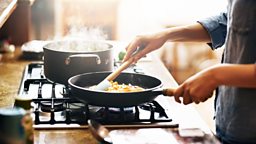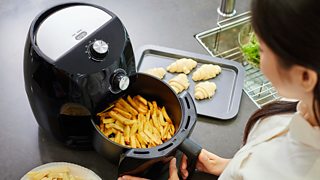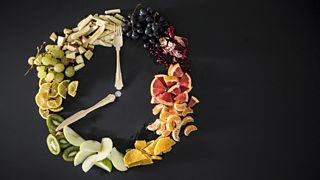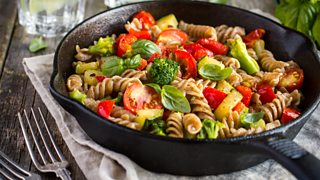Which pots and pans are best for your kitchen?
With all the work involved in preparing a meal, cooking it and then cleaning up afterwards, the last thing we want to stress over is whether we're using the right equipment. But listener Emily needed help navigating the wide range of pots and pans out there. What material is best? And is non-stick coating really safe to use?
In a cookery-themed episode of 麻豆社 Radio 4's Sliced Bread, presenter Greg Foot is heading into the kitchen to separate the ceramic from the stainless steel and the anodised aluminium from the Teflon. He chats with restaurateur Tim Hayward and Doctor Chris Hamlett from the University of Birmingham's Metallurgy Department to figure out what materials we should be looking for in our cookware. Here's what he found out about all the options around…

Cast iron pans are fantastic for searing meat
Cast iron pans usually get shout-outs from professional chefs who treat them like their most prized possession. But is all the hype really justified?
Restaurateur Tim Hayward admits he used to have a full range of cast iron pans, but now he's cut it down to just one that he uses for searing to get that beautiful crust. He explains that cast iron pans have “thermal mass… it's got a lot of ‘stuff’ in it to take the heat, hold the heat and move it around.” In other words, the heavy base evenly disperses the heat once it gets up to temperature. Of course, that heavy base can also put off home cooks who don't want to tote a massive iron slab around after a long day’s work.
There's also a lot of mythologising around seasoning cast iron pans, with some cooks claiming it's destructive to wash a cast iron pan out. There is some truth to this – coating the cast iron pan with seasoning and oils helps to create a non-stick effect that prevents meat from clinging and burning in the pan. Since Tim only uses his cast iron for searing, he's often happy to just wipe it out with a piece of paper towel and hang it back up on the hook. For home cooks who are squeamish about hygiene, there's no need to worry – you can definitely clean a cast iron pan with soap without any ill effects.
Stainless-steel pans are the all-purpose workhorses of the kitchen
Given how unwieldy a cast iron pan can be, stainless-steel pans are often preferred for everyday cooking.
Tim uses a deeper stainless-steel pan so he can toss the contents more easily and even boil or steam food in it. Stainless-steel pans have the same heavy base of a cast iron pan to get that heat-dispersal effect, but unfortunately will take much longer to get up to temperature.
The real reason stainless steel is such a great material is in the name – you have to go some to tarnish it. That means stainless steel pans don't need a coating! But just be careful, as this rule only applies to stainless-steel products from reputable brands. A cheaper brand will leach nickel and chromium into your food over time, which can have mild negative effects on your health.
For that reason, Greg advises that it's best to avoid cleaning stainless steel with vinegar or using metal scourers that will create scratches in the smooth surface. Keep it simple by just using soap and water!
Anodised metal pans protect your food and keep cookware light
There are plenty of metal pans that are great for heating, but they require special treatment to keep them protected. The most common are anodised aluminium pans, a lightweight piece of cookware that heats up quick, feels light and costs far less than many of the other options.
The premium option, however, is anodised titanium – the Rolls-Royce of cookware materials. Anodised titanium pans have all the benefits of cast iron cookware, but with just one-third of the weight.
What does ‘anodised’ actually mean though? Essentially, anodised metals have had an electric current passed over them to produce an oxide layer that acts as the pan's coating. Aluminium pans, for example, have an anodised aluminium oxide layer that protects them from reacting with strongly acidic or alkaline foods.
Non-stick pans aren't all they're cracked up to be
Non-stick pans seem like a dream. They're by far the best pans for preventing food from sticking and burning, mostly used for food like scrambled eggs that can easily catch and ruin a perfectly good pan. Pans coated with Teflon require care when using, however. Tim recommends only using silicon spoons and spatulas in the pan to prevent damaging the non-stick coating.

Once you get to a certain temperature, all pans are non-stick.Restauranteur Tim Hayward
However, Tim explains that non-stick coating isn't the be-all-and-end-all of a pan's functionality: “Once you get to a certain temperature, everything is non-stick. If you put a steak into a hot enough pan, it hovers on its own level of steam and seals itself off on the underside.”
Additionally, sometimes we want food to stick to the pan. Imagine making a sauce and sweating off the finely-chopped vegetables. Sticking causes caramelisation, releasing flavour when the pan is deglazed with alcohol or water.
Concerns around using Teflon in food preparation are mostly outdated
Many tall tales float around about the dangers of using Teflon pans. Some claim that Teflon is carcinogenic, while others are fearful of chipped non-stick coating shedding microplastics into their food.
The good news is that Teflon is perfectly safe under normal cooking conditions. Teflon is the brand name of a chemical called polytetrafluoroethylene (PTFE for short), a long-chain polymer which is extremely hydrophobic and oil repellent. The University of Birmingham's Doctor Chris Hamlett explains that PTFE used to be made with a hazardous precursor called PFOA, which in one famous case in 1980s West Virginia was dumped into the water around manufacturing plants. PFOA can cause a range of issues, from infertility to thyroid problems. Thankfully, PFOA is no longer used, having been banned in the UK since 2005.
The only way PTFE (Teflon) could be hazardous is when pans are heated beyond 260 degrees Celsius. This can release fumes that cause flu-like symptoms in anyone unlucky enough to inhale them. But Tim tells us that under normal conditions, this isn't going to happen: “You would have to put it on a big gas burner, crank it and let it go for a long time.” Most stove tops won't get a non-stick pan that hot, and it would take hours of preheating to cause this effect – something you shouldn't be doing with a non-stick pan anyway.
Ceramic-coated pans are more durable than Teflon pans
If you're still concerned about using Teflon non-stick pans, Doctor Chris Hamlett has another alternative – ceramic non-stick pans. Ceramic pans have a silicon oxide layer which is far harder to chip, preventing the gradual build up of grooves that can catch proteins from cooked food. Ceramic pans are also more environmentally friendly than Teflon pans, since PTFE is a ‘forever chemical’ – a chemical that takes an incredibly long time to degrade in nature.
Ultimately, which pan you choose will depend on what you're cooking and your own convenience. Stainless steel pans are great all-rounders, while non-stick pans are best used for delicate ingredients like egg and fish. You may also find that added features like removable handles are a must-have for storing and cleaning your pans.
The future of pan technology involves combining all of these materials together in various combinations to get all the benefits in one package.
To hear more about the ins and outs of modern composite pans, and to find out what listener Emily made of Greg's findings, listen to the full episode on 麻豆社 Sounds.
The information contained in this article was correct at the time of broadcast on 22 February, 2024.

More articles from 麻豆社 Radio 4
-
![]()
Can cooking with an air fryer save you money?
Seven things to consider before buying the latest must-have kitchen gadget.
-
![]()
Change WHEN you eat, not WHAT you eat
Could regimenting your mealtimes be the key to staying healthy?
-
![]()
How did tea become the nation's favourite drink?
All Consuming looks at the past, present and future of tea in the UK.
-
![]()
Five simple food tips for better health
Prof Tim Spector offers a handful of invaluable food tips for Just One Thing.





